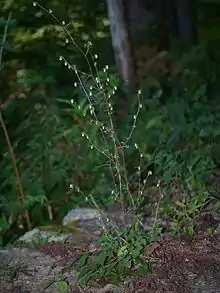Carpesium
Carpesium is a genus of flowering plants in the aster family, Asteraceae.[1][2] They are distributed in Europe and Asia; most occur in China and several are endemic to the country.[3]
| Carpesium | |
|---|---|
 | |
| Carpesium rosulatum | |
| Scientific classification | |
| Kingdom: | Plantae |
| Clade: | Tracheophytes |
| Clade: | Angiosperms |
| Clade: | Eudicots |
| Clade: | Asterids |
| Order: | Asterales |
| Family: | Asteraceae |
| Subfamily: | Asteroideae |
| Tribe: | Inuleae |
| Genus: | Carpesium L. |
| Type species | |
| Carpesium cernuum | |
These are mainly perennial herbs, but a few species are annuals. The alternately arranged leaves have smooth or toothed edges and are sometimes borne on winged petioles. The flower heads occur at the ends of branches or in the leaf axils, alone or in clusters. There are many yellowish disc florets at the center and usually some tubular or ray-like florets around the edge of the head. The fruit is a hairless, ribbed, beaked achene.[3]
Several species, including C. abrotanoides,[4] C. divaricatum,[5] and C. rosulatum,[6] have been used in traditional medicine in China and Korea.
- Carpesium abrotanoides
- Carpesium cernuum
- Carpesium cordatum
- Carpesium divaricatum
- Carpesium faberi
- Carpesium gigas
- Carpesium glossophyllum
- Carpesium humile
- Carpesium kweichowense
- Carpesium leptophyllum
- Carpesium lipskyi
- Carpesium longifolium
- Carpesium macrocephalum
- Carpesium minus
- Carpesium nepalense
- Carpesium rosulatum
- Carpesium scapiforme
- Carpesium spathiforme
- Carpesium szechuanense
- Carpesium trachelifolium
- Carpesium triste
- Carpesium velutinum
- Carpesium verbascifolium
- Carpesium zhouquensis
References
- Linnaeus, Carl von. 1753. Species Plantarum 2: 859-860 in Latin
- Tropicos, Carpesium L.
- Carpesium. Flora of China. 天名精属 tian ming jing shu
- Wang, F., et al. (2009). Sesquiterpene lactones from Carpesium abrotanoides. Fitoterapia 80(1), 21-24.
- Zee, O. P., et al. (1998). Thymol derivatives from Carpesium divaricatum. Archives of Pharmacal Research 21(5), 618-20.
- Moon, H. I. and O. Zee. (2010). Antiproliferative effect from sesquiterpene lactones of Carpesium rosulatum Miq. consumed in South Korea on the five human cancer cell lines. Records of Natural Products 4(3), 149-55.
- Carpesium. The Plant List.
- Flann, C (ed) 2009+ Global Compositae Checklist
 Media related to Carpesium at Wikimedia Commons
Media related to Carpesium at Wikimedia Commons